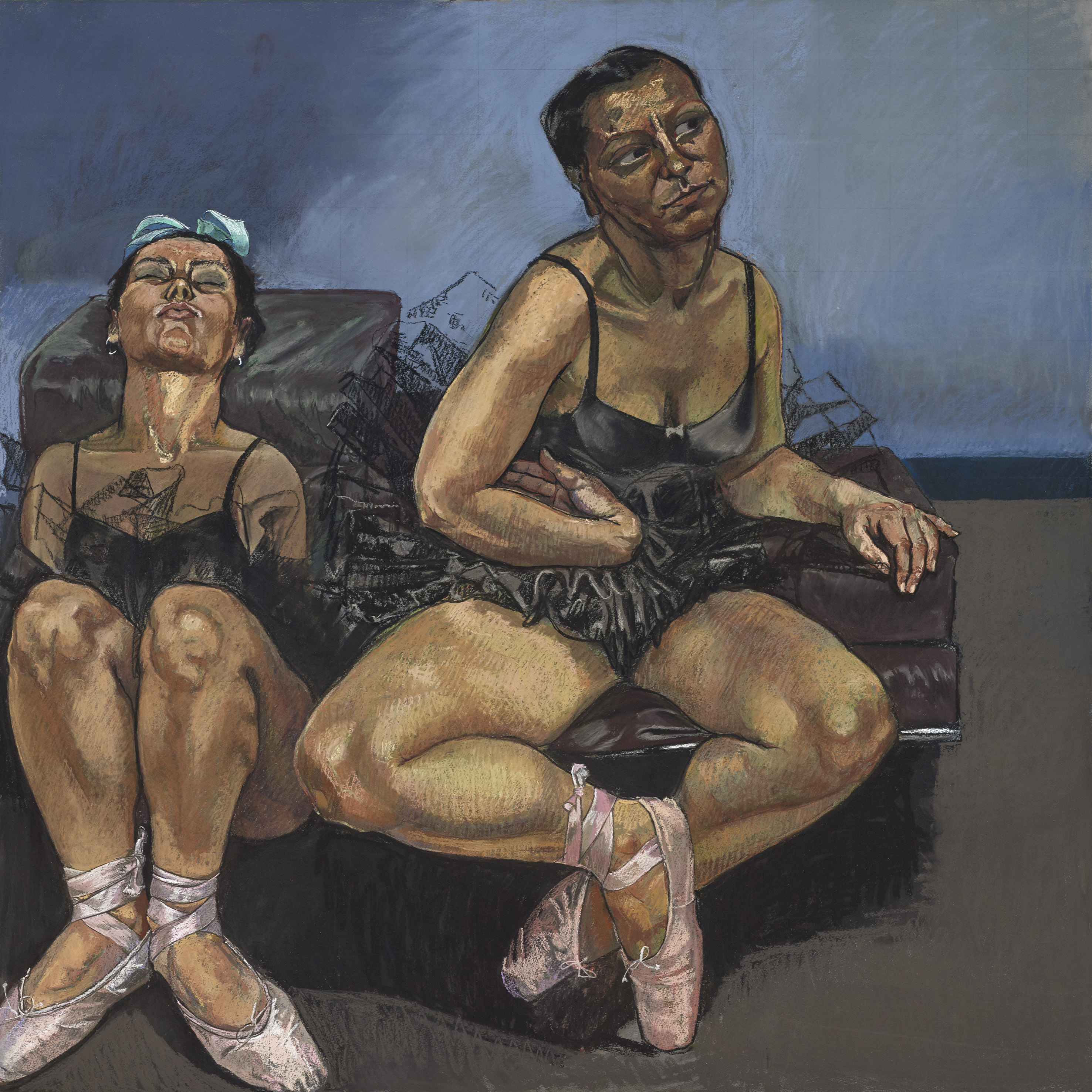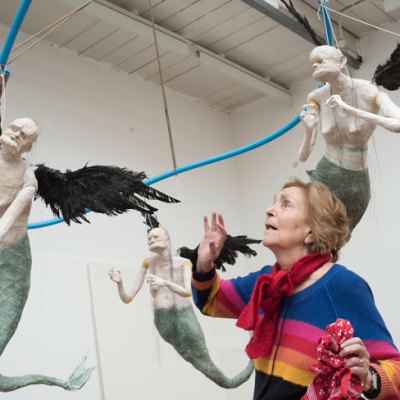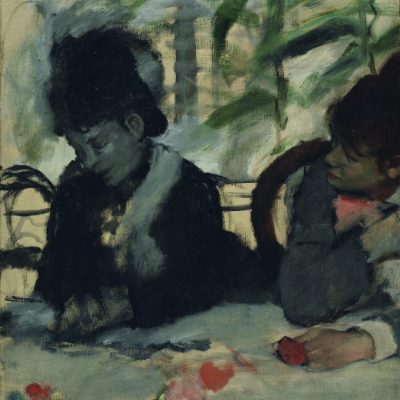A young girl bends towards a dog, whose tail is tucked between its hind legs; she is clasping its front paws. Her puffed-out skirt billows behind her. One needn’t have in mind the title of the painting that depicts this scene – Snare (1987) by Paula Rego – to sense that something disturbing is taking place. All of Rego’s works inspire a kind of diffuse malaise. Here, through contrasts of scale, the picture dramatises a power relation between its protagonists: a tiny horse drawing a carriage tries to escape in the bottom right corner, making the girl appear threateningly gigantic – apart from her unsettlingly small feet. The image is full of unanswered questions. Why is the girl’s skirt so big? In a letter composed the same year as the painting – decades before the release of Mean Girls – Rego wrote: ‘it is like a snail’s shell, and it has “secrets”.’
Snare (1987), Paula Rego. Courtesy the British Council Collection; © Paula Rego

For the French public, Rego herself is something of a secret. That is to say, she is scarcely known. But ‘The cruel stories of Paula Rego’, on display at the Musée de l’Orangerie in Paris this autumn, may herald a shift in fortune. While some 70 larger format works (pastels and acrylic paintings) and engravings on display constitute a selective tour through her work rather than a proper retrospective, this is Rego’s biggest solo show in the country to date. Why is it that such an important artist, celebrated in her native country of Portugal and in the UK, where she studied, lived and exhibited, should have remained overlooked in France? One response lies in her work’s claim to a tradition of narrative representation with deep roots in Britain, dating back at least to Hogarth, which historically has been little appreciated in France.
At l’Orangerie, the various subjects of Rego’s story-telling, drawn from a heteroclite assemblage of children’s and folk tales and 19th-century novels, are further illuminated through juxtaposition with historic works chosen from the museum’s collection – Bourgeois, Doré, Goya, Hockney, and Redon, among others. Theatrical ballerinas in Dancing Ostriches from Disney’s Fantasia (1995) are shown next to Degas’ iconic dancers. But Rego’s look more drained, if not desperate. The gruesome Dog Woman (1994), part of the series in which she first explored working with pastels, is abrasive, even raw. Degas once said of pastel that it enabled him to instil a certain animality in his subjects, whom he described as like ‘female cats licking themselves’.
Dancing Ostriches from Disney’s Fantasia (left panel of triptych; 1995), Paula Rego. Courtesy Marlborough Fine Art; © Paula Rego

While each work is composed of its own skein of references, they together manifest the artist’s distinctive voice. Flouting the male gaze, they upset archetypes. In the most recent pastels in the show, Rego has transformed the four male painters of Balzac’s Unknown Masterpiece into women artists – no abject muses here. Rego’s women are larger than life, thick sculpted bodies with a force and solidity rarely found in representations. In The Blue Fairy Whispers to Pinocchio (1996), she has her daughter, the actress Victoria Willing, sit as a realistic version of the mythical figure; in Gepetto Washing Pinocchio, painted the same year, the Australian artist Ron Mueck (Rego’s son-in-law) is a carpenter holding close to his lap the child, arms pulled behind and stiff as a board. The figure of Pinocchio is based on one of Mueck’s hyperrealistic miniaturised statues, also present in the show. Family is one of Rego’s main topics – with its hierarchies and power plays it’s as political as it is personal. Take The Family (1988), in which it’s unclear whether the male father figure is being dressed or assaulted by the three women who surround him.
Geppetto washing Pinocchio. Courtesy Marlborough Fine Art; © Paula Rego

Spotlit in the dimmed exhibition rooms, like on a stage, each painting seems to come out of a different nightmare. They are filled with the narrative twists that transform the everyday into the fantastic: the children were bleeding but they all had rabbit heads (like in War, a pastel based on a photograph of a little girl in Iraq in 2003); our dad was sleeping on the sofa but he was actually a giant pillow (as in The Pillowman, a triptych named after a play by Martin McDonaugh). Their meaning is as impenetrable as a dream.
‘The cruel stories of Paula Rego’ is at the Musée de l’Orangerie, Paris, until 14 January 2019.



